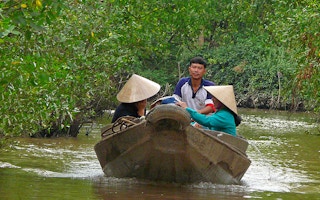The effects of the severe drought that the El Niño weather phenomenon—exacerbated by climate change—delivered to Southeast Asia this year will be felt for months, if not years, to come in the economically vital Mekong Delta, environmentalists and United Nations experts said.
They also said Vietnam and other Mekong states must brace for an increase in extreme weather events, bolstering early disaster preparedness and response activities to mitigate the potentially devastating effect impact on tens of millions of people and natural resources.
“These types of extreme climate events are foreseen to increase in number and seriousness in the future, which intensifies the current desertification trends in several areas in Vietnam,” said Vu Minh Hai, a senior program manager and chairman of the Climate Change Working Group in Vietnam, a member organisation of the NGO network Climate Action Network-International.
Even though the latest El Niño—a weather event that occurs every four to five years and triggers drier and hotter weather conditions in countries in the Southeast Asian monsoon zone—wound down in Vietnam in September, it left in its wake diminished water supplies, risks to people’s health and food security, and a loss of livelihoods.
This El Niño was the strongest ever to hit the Mekong Delta, the fertile region in southwestern Vietnam where the Mekong River empties into the sea through a network of channels, and which is one of the world’s top rice producers and exporters.
“
These types of extreme climate events are foreseen to increase in number and seriousness in the future, which intensifies the current desertification trends in several areas in Vietnam.
Vu Minh Hai, senior program manager and chairman, Climate Change Working Group Vietnam
The weather system ushered in an increase in storms in 2015, followed by the worst drought in the Mekong Delta area in 90 years, wreaking havoc on the area’s fragile ecosystem and the lives of many of the more than 20 million people who live there.
The climate change issue is “very serious for particular parts” of Southeast Asia, said David Nabarro, the United Nations special adviser on the 2030 Agenda for Sustainable Development, during a briefing with reporters at the Social Good Summit in New York in September.
“In the Mekong Delta, we see salination is coming up the river, and it’s affecting the productivity of quite a bit of the land in southern Vietnam, and it’s also affecting parts of Cambodia,” he said. “That whole climate change issue is hitting hard in that region.”
Extreme weather patterns like El Niño, which scientists believe are related to climate change, are increasingly causing slow-onset disasters that pose problems for the global humanitarian system, drive people away after they have lost their livelihoods, and undermine economic development, experts said.
“It’s heartbreaking to see poor countries seeing their development undermined because of climate change that is human-induced now,” said Mary Robinson, one of two special envoys on El Niño and climate appointed by United Nations General-Secretary Ban Ki-moon in May.
“Make no mistake about it, it is human-induced, and we are responsible for undermining the development chances—people who haven’t been held responsible for eliminating greenhouse gas emissions,” she said during a briefing with reporters at the Social Good Summit in New York in September.
High cost of El Niño
The government of Vietnam has estimated the total economic loss from El Niño at 15 billion dong (U.S. $660.8 million), or 0.35 per cent of national GDP, with negative agricultural growth of 0.18 percent for the first time in decades for all affected parts of the country, according to a drought recovery plan issued on Oct. 17 that includes measures to be taken in the short, medium and long terms.
The intense drought that peaked in the country between February and May brought record-high salt levels and severe water shortages. About 2 million people had no access to water for consumption and domestic use, 2.2 million were food insecure, and more than 2 million lost income due to damaged or lost livelihoods, the report said.
Though drought conditions in Vietnam ended in September, their ramifications have created an ongoing need for humanitarian assistance.
“[The] drought impact for affected households is still lingering and needs are pertinent, particularly in terms of water storage and purification, hygiene and nutrition support, disease surveillance and response, and livelihood recovery,” the report said.
The drought recovery plan lays out myriad goals aimed at ensuring that the 18 provinces affected by the drought, including those in the Mekong Delta region, receive water and water treatment supplies, foods, seed packages, nutritional supplements, essential medicines, and fish and poultry restocks.
The plan also will provide irrigation infrastructure repairs, cash-for-work programs, and technical assistance and technology for improved meteorological and disaster forecasting.
The provinces have estimated that the total cost of the recovery from now until 2020 will be more than $1.2 billion, the report said.
Copyright © 1998-2014, RFA. Used with permission of Radio Free Asia, 2025 M St. NW, Suite 300, Washington DC 20036. Read the full story.








